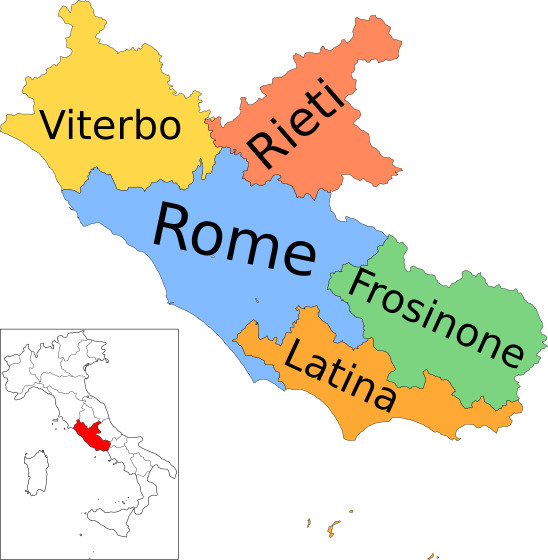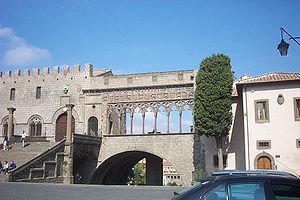Lazio (Latium) is a central region of Italy. Rome is more or less in the middle of the region but Lazio has numerous other attractions and would well repay a visit even if Rome did not exist. The region has many fascinating cities, several lakes, some beautiful scenery, good opportunities for country and hill walks and a coastline that is almost entirely beach, which is enhanced by hundreds of excellent fish restaurants. Communications are good, particularly going north-south.
Provinces
editLazio is divided into four provinces and one "metropolitan city" that is equivalent to a province:
| Frosinone (FR) |
| Latina (LT) |
| Rieti (RI) |
| Metropolitan Rome (RM) Italy's largest urban region, with 4.4 million citizens. Officially designated as a "metropolitan city". |
| Viterbo (VT) |
Cities
editOther destinations
edit
- 1 Sacro Bosco (Park of the Monsters) in Bomarzo
- 2 Castelli Romani - this hilly area of several small towns, refreshingly cool in summer, has been a retreat for Romans since ancient times
- 3 Fossanova Abbey - an important and still active early Gothic monastery
- 4 Lake Bolsena (Lago di Bolsena)
- 5 Lake Bracciano (Lago di Bracciano) - here was built the first Italian military airbase, today the Italian Air Force Museum.
- 6 Monte Cassino - home to a WWII cemetery, and nice views.
- 7 Ostia Antica - the harbour facilities of Imperial Rome, built by order of emperor Claudius.
- 8 Sabine Hills - former home of the Sabine tribe, rivals to the Etruscans and Romans.
- 9 Vulci - deserted former Etruscan city with many ruins from a necropolis in a former castle
Understand
edit- See also: Roman Empire, Medieval and Renaissance Italy
For centuries, people have been saying that "all roads lead to Rome", and in Lazio, that is hardly an overstatement, as the ancient, modern capital city of Italy dwarfs the rest of the region in importance and interest to travellers. The world-class attractions in Rome include the Colosseum, the Forum, the Campidoglio, the Vatican, Piazza Navona and the Pantheon, but there are literally hundreds of worthwhile attractions in Rome, such that even if you lived there for a year and went sightseeing every day, you couldn't see them all.
The area to the northwest of Rome is made up of the province of Viterbo, and part of the province of Metropolitan Rome. The main city is Viterbo, about 100km to the north of Rome, which was the favourite residence of the Popes when they faced difficulty in exercising their authority over Rome. North of Rome was a center of the Etruscan civilization before its defeat by the Romans. Many Etruscan sites remain, in particular the tombs at Cerveteri, Tarquinia and, to a lesser extent, Sutri, the ruins at Veio, which was at one time the richest Etruscan city, and excellent museums at Vulci, Tarquinia, and Villa Giulia in Rome.
To the northeast of Rome are the Sabine Hills, whose women were famously raped (abducted) by the Romans when invited to a festival in Rome by Romulus. Further to the northeast in Rieti province is the attractive town of Rieti of interest to American basketball fans as the childhood home of Kobe Bryant.
East of Rome is Tivoli, with the garden of fountains at the Villa D’ Este and the extensive and well preserved grounds of Hadrian’s Villa. To the east and southeast are two fascinating monasteries. At Subiaco St. Benedict founded the Benedictine order, while Monte Cassino was another important monastery but these days is best known as the site of a major World War II battle. South of Rome are the fishing port of Anzio, also a major WW2 site, and the Castelli Romani, with Castel Gandolfo, the summer home of the Popes, and Frascati, famous for its wine. The two southern provinces are Frosinone and Latina, which combine agriculture and light industry. Interesting places to visit include the coastal towns of Gaeta and Sperlonga as well as Anagni, former home of the Popes, and Fiuggi, a spa town.
Climate
edit| Lazio | ||||||||||||||||||||||||||||||||||||||||||||||||||||||||||||
|---|---|---|---|---|---|---|---|---|---|---|---|---|---|---|---|---|---|---|---|---|---|---|---|---|---|---|---|---|---|---|---|---|---|---|---|---|---|---|---|---|---|---|---|---|---|---|---|---|---|---|---|---|---|---|---|---|---|---|---|---|
| Climate chart (explanation) | ||||||||||||||||||||||||||||||||||||||||||||||||||||||||||||
| ||||||||||||||||||||||||||||||||||||||||||||||||||||||||||||
| ||||||||||||||||||||||||||||||||||||||||||||||||||||||||||||
Much of the region is known for its balmy Mediterranean climate. It has prolonged hot, dry summers and short, mild winters. The intermediate seasons are generally warm and guarantee the possibility to sunbathe for most of the year.
Get in
edit- Civitavecchia, the port of Rome, is the point of arrival and departure of hundreds of ships, cruises, ferries travelling all around the Mediterranean. From here it is possible to reach Sardinia, Corsica, Sicily, Spain, France, some other small islands, and even north Africa. A good transportation system links the port to the Eternal City.
- By car the whole of Lazio is easily accessible, via the A90 ring road (or GRA), from Rome’s airports at Fiumicino and Ciampino (see Rome for details).
Get around
edit- The main A1 toll highway (Autostrada) from Florence to Naples provides good north-south communications. The A24 heads east from Rome to the mountains of the Abruzzo. Other important highways in northern Lazio are the A12, which follows the coast north in the direction of Pisa in Tuscany and the Cassia (and Cassia bis), which is the main road to Viterbo. Southern Lazio is served by the Pontina, which can get very crowded on summer weekends.
- There is a good rail network. Most routes are north-south via Rome rather than east-west. Bus services are also available, if infrequent.
See
edit
Aside from the places mentioned in the "Understand" section, the countryside is quite pretty, and despite the fact that Lazio is the region of Rome, there is also quite a lot of countryside.
Do
editEat
editRoman cuisine is delicious; you can read some about it at Rome#Eat. In Lazio, you can also find delicious fresh seafood at places along the coast.
Drink
editLazio has a well-known and well-reputed wine industry of very long standing. Otherwise, remarks at Italy#Drink apply.




